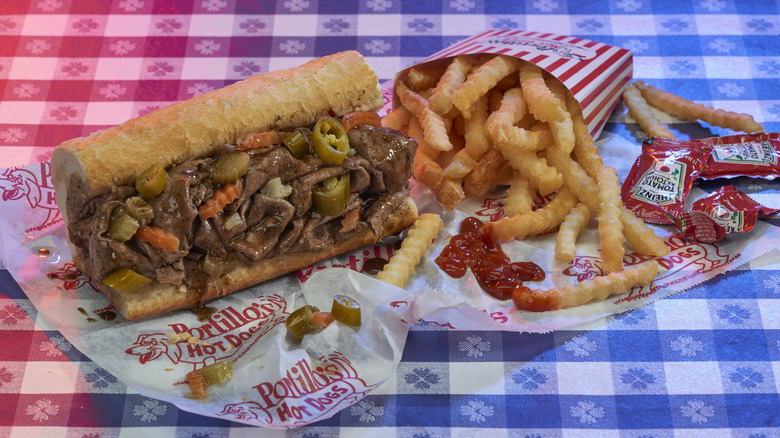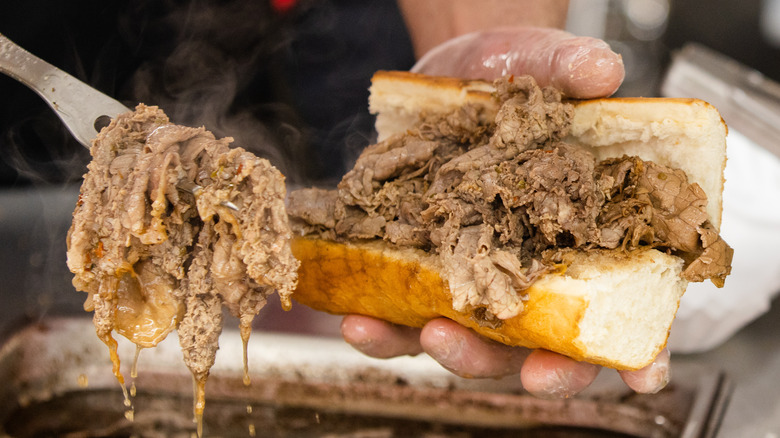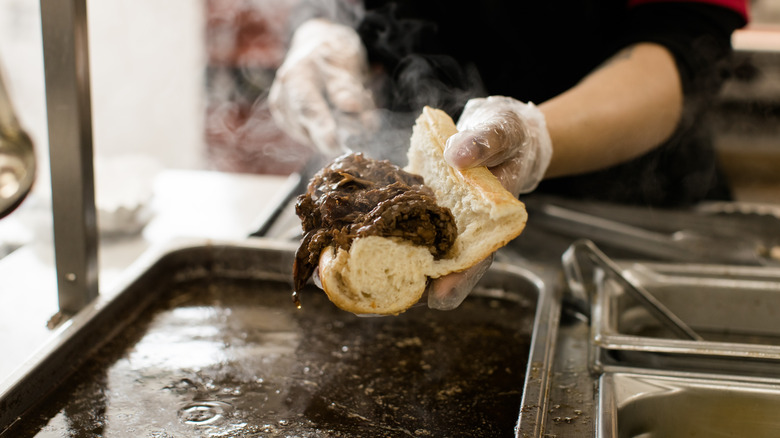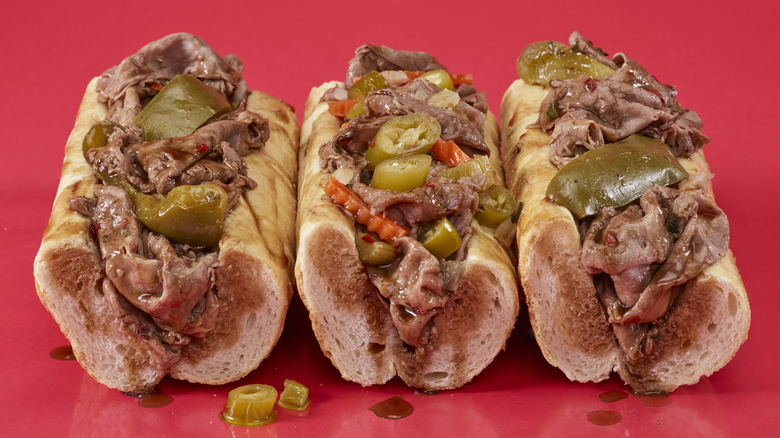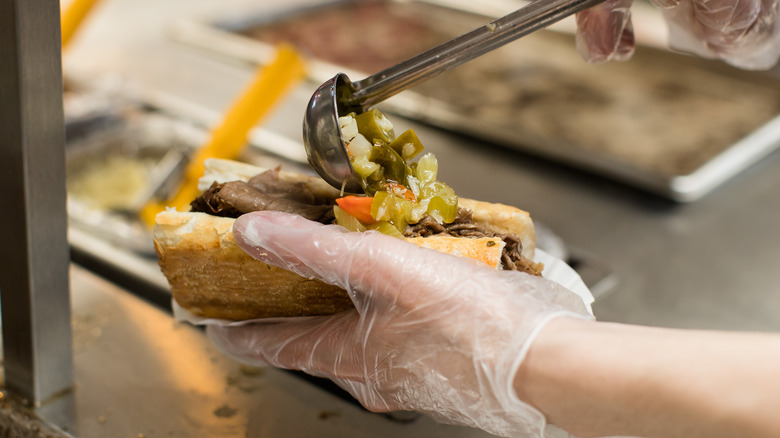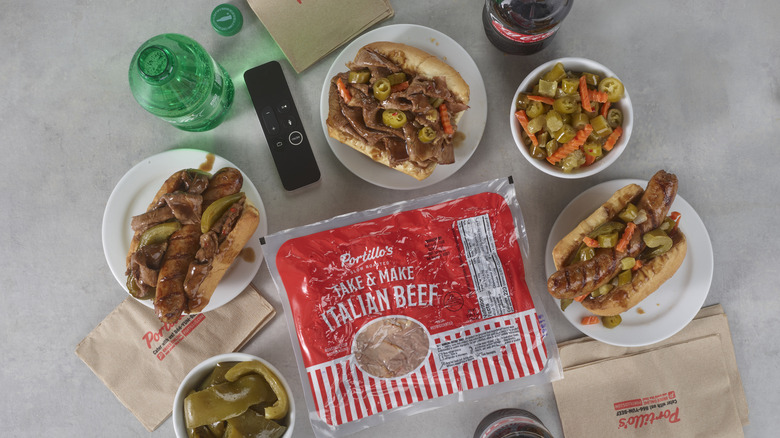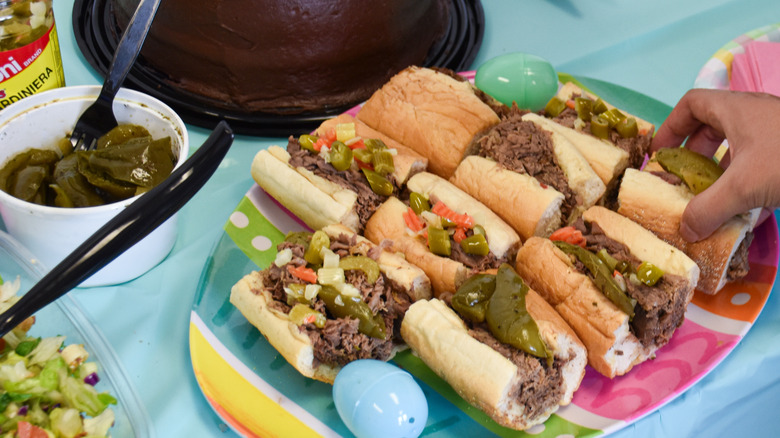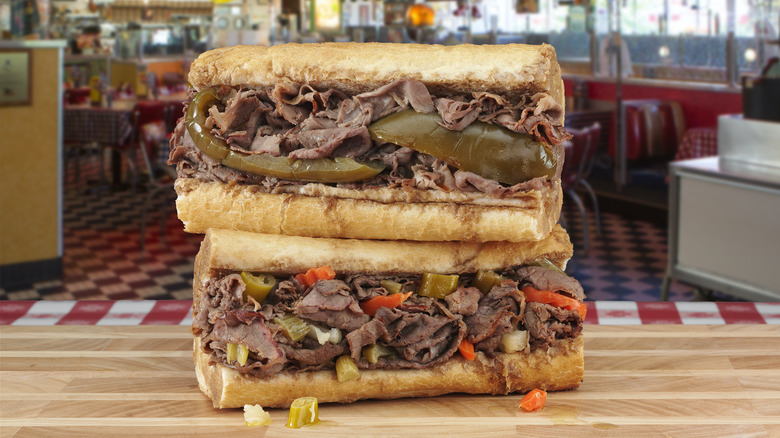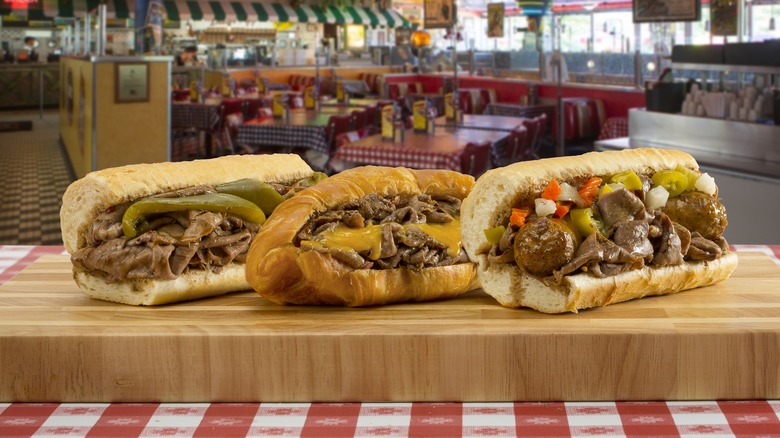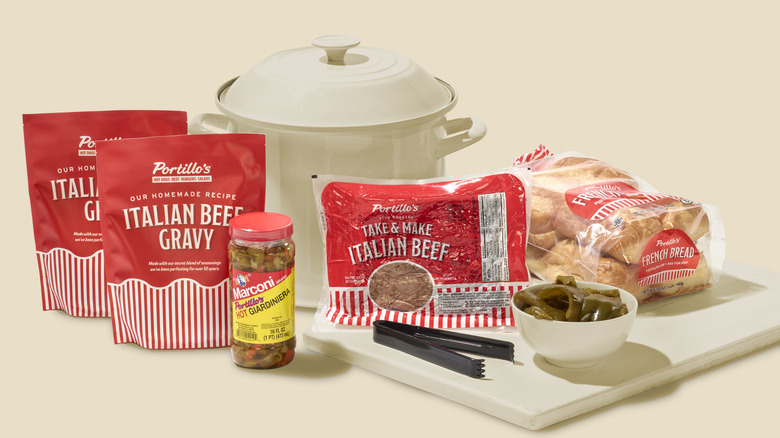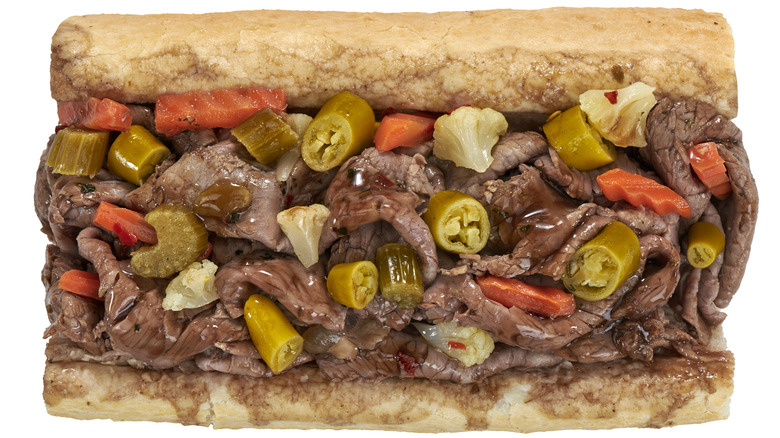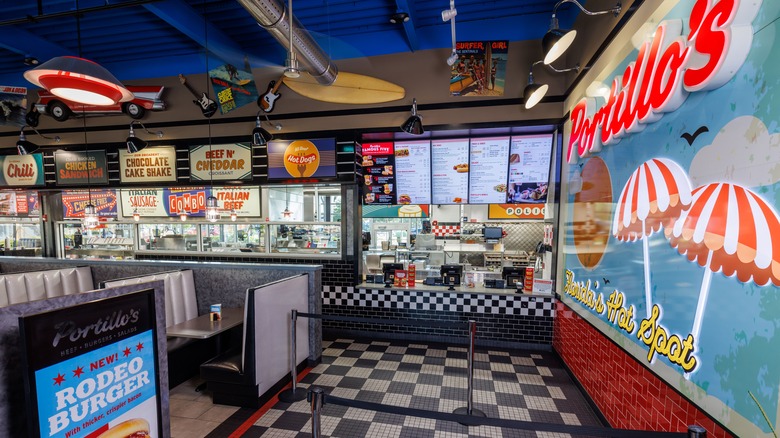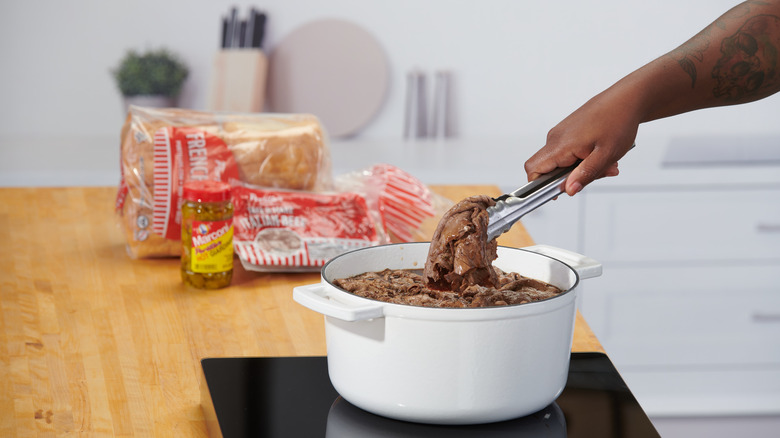Here's Why Portillo's Italian Beef Sandwich Is One Of The Best Around
Unless you live in Chicagoland, it can be a rare experience to sink your teeth into an Italian beef sandwich. I was first introduced to the Windy City staple more than a decade ago when a visit to my now-husband's hometown included a required stop at Portillo's. My first order at the fast-casual restaurant chain was an Italian beef sandwich, a bit of extra gravy, and sweet and hot giardiniera. I had no notes.
Portillo's began as a hot dog stand in the 1960s, with a four-item menu: Chicago-style hot dogs, tamales, fries, and soda (or pop, for true Chicagoans). When the original owner Dick Portillo expanded the menu in the 1970s, Italian beef sandwiches hit the menu — and stayed there.
There's debate about which Chicago beef purveyor first started slinging these savory, jus-laden sandwiches, but legend agrees that the sandwich has its roots in Italian-American weddings in the early 1900s, when families tried to feed their guest lists as economically as possible. Tough cuts of beef, roasted and then sliced thin onto sandwiches and slathered in the beef's "gravy," or juices from the roasting process, became a delicious way to do that.
Since then, the number of Italian beef shops across Chicagoland have exploded. And while some might claim to have done it longer, or in a more niche way, none have brought Italian beef to the masses quite like Portillo's. Here's why the restaurant's Italian beef is one of the best around.
Portillo's Italian beef has been prepared the same way for decades
To get a behind-the-scenes look at how Portillo's prepares its Italian beef sandwiches, we spoke with Garrett Kern, the company's Vice President of Strategy and Culinary. Kern, along with the rest of the Portillo's team, knows just how important the sandwich is for their patrons. "It's one of those sandwiches that has broad universal appeal," Kern said. "But it also holds a really special cultural place in the heart of Chicagoans."
Portillo's uses cuts of beef shoulder for its Italian beef, which would be tough if you tried to grill them or prepare them in many ways. But the sandwiches feature incredibly thin, melt-in-your-mouth strips of beef — a result of the right cooking process in action. "It's slow roasted and then it's cut against the grain so that it's tender," Kern explained. It takes four hours of roasting to get to the point where it's ready to slice and serve.
The humble cuts aren't impressive compared to a prime steak, but Kern said Portillo's takes care with how it sources them for the restaurants. "We look for consistency in fat content because that's important for beef," he explained. Still, the rest of the ingredients in the sandwich are what bring it to life, Kern added. "It's really in the cooking process and the gravy that makes it shine."
The gravy was perfected over 50 years, and is now top secret
One component transforms Italian beef into a magical flavor bomb: gravy. Fat and juices are rendered from the beef during the roasting process, and it's mixed with herbs and seasonings that give Italian beef its craveable umami qualities.
Gravy recipes for Italian beef are sacred, and Portillo's is no different. Even Kern has a general knowledge of what goes into it but doesn't know the exact proportions. "The recipe for our beef gravy is sort of like the 11 secret herbs and spices for KFC," he said. In fact, asking for further details was like trying to break into Fort Knox. "The best way to keep a recipe secret is to make sure as few people know it as possible," Kern said. "We make sure that we have some redundancy in the organization but it's like needing two keys to unlock something."
Kern said a key factor that sets Portillo's gravy apart is that the chefs trim the beef, and then use those fat trimmings in the gravy for extra depth of flavor. We're on our own for intuiting the rest of the gravy ingredients, though. "If you were to shop the spice aisle and be like, I need to make an Italian seasoning, you would kind of guess what's in there," Kern hinted. "I think ours has a balance between a little bit of kick and heat, as well as those Italian herbs."
Portillo's has a decades-long partnership with Turano Baking for its French bread
Portillo's commits to what works when it comes to ingredients. That philosophy extends to the bread the chain uses for its sandwiches, which comes exclusively from Chicago-based Turano Baking Company.
Kern explained why: French bread is traditionally used for Italian beef sandwiches because of its open cell structure. That structure allows it to absorb the juices from the gravy without immediately disintegrating. "We have partnered for decades and decades, basically since we've been offering Italian beef, with Turano Baking," Kern said. "They make the best bread for Italian beef because when you toast it, the outside gets a little crispy, a little crunchy, but the inside will still be soft and absorbent."
The bread quality is what allows patrons to customize their gravy orders on Italian beef. Kern says the "Portillo's way" is to get a little extra gravy drizzled on top, while still retaining some texture on the outside of the sandwich. It's also popular to get the sandwiches dipped completely in the gravy before being wrapped and handed to you so that the gravy permeates the entire roll. The brave — and those willing to have gravy drip down their forearms — can opt for "extra dipped." The sandwich is soaked in flavorful jus, but it's a race against time to eat it before it starts falling apart in your hands.
The restaurant prioritizes texture in its giardiniera
The final core ingredient for Italian beef is the Italian vegetable relish called giardiniera. Vegetables are pickled and marinated in oil, then sprinkled on top of Italian beef. Portillo's gets a proprietary blend of giardiniera directly from Marconi, an iconic brand that's easiest to find on grocery shelves in the greater Chicago area. I've tried buying brands of "giardiniera" outside of the Chicago area, and it's not remotely the same texture or punchy bites you get from the localized stuff. Thankfully, Marconi sells some of its versions online.
Kern said Portillo's prioritizes texture in its giardiniera, which comes primarily from carrots, celery, and cauliflower in the mix. The spicy version includes serrano peppers that add crunch, too. This texture is vital: The beef is thin and doesn't have much chew, and the gravy softens the bread. Giardiniera adds a texture and flavor contrast that keeps you going back, bite after bite. "Having those [vegetables] pickled and then blended with the oil, not only do you get the texture, you get the bursts of flavor, but then the oil permeates the sandwich and gives it a unique flavor throughout," Kern said.
If your spice tolerance is nonexistent, Portillo's also roasts sweet bell peppers in-house that you can add instead. According to Kern, a fairly even mix of customers orders sweet and hot peppers — or both.
Portillo's uses centralized kitchens to maintain flavor and quality
Though Portillo's started out as a small-scale operation, the brand now operates 86 restaurants across 10 states, primarily in the Midwest and now expanding to sunbelt states like Arizona, Texas, and Florida. In a unique decision for many expanding restaurants, Portillo's chose to retain all operations under a corporate banner, rather than franchising to local owners.
Among many reasons for doing so, this allows Portillo's to use its centralized commissary kitchens to efficiently cook and package all the ingredients for its Italian beef sandwiches, then send them to each restaurant. The end result? The flavors you fell in love with from your Italian beef in Deerfield, Illinois are the same as you'll get in Tucson, Arizona.
Kern explained how Portillo's keeps the flavors fresh: The beef is slow-roasted, sliced, and packaged in the kitchens, then sent out to restaurants alongside the gravy. The gravy is simmered on-site and the beef is heated and soaked in it right before landing on a sandwich. Cooking the beef has gotten more efficient with time, Kern said, but the commitment to a quality sandwich hasn't changed. "The beef itself, the gravy itself, the bread, the way that we handle those products, the process for how much we put on, the right way to put it on has remained very similar and we take a lot of pride in that," he explained.
Portillo's sells millions of dollars worth of Italian beef each year
If you need any further convincing that Portillo's knows its Italian beef, the sheer quantity the restaurants sell in a year should be all the proof you need. Portillo's team said that each restaurant location does about $9.1 million in sales each year, and about 21% of those sales in each restaurant comes from Italian beef. (If you take $1.9 million multiplied by 86 sites, that's more than $164 million in Italian beef sales per year alone.) Regardless of restaurant location, the team said Italian beef sandwiches are the most popular menu item.
Those sales don't happen by accident, Kern said. It helps that Portillo's has a broad variety of menu items: If for some reason you're not in the mood for Italian beef (we can't relate, but you do you), Portillo's sells its staple Chicago-style hot dogs, Italian sausage, burgers, chicken, salads, cake shakes, and more. The chain also makes sure you can order in as many ways as possible if you're lucky to have one close by. Portillo's invests in getting its delivery, takeout, and dine-in options as plentiful as possible from the start, ensuring you can get your Italian beef how and when you want it.
It's easy to hack the original sandwich for unique options
Traditional Italian beef sandwiches are favorites for a reason, but for the creatives in the group, there are a number of ways to make the sandwiches more unique. Kern said that as low-carb diets grew popular, growing numbers of customers would ask for the Italian beef and peppers without the bread. In fact, it's now on the menu as "beef bowls."
A popular hack that doesn't sacrifice the precious bread includes dousing the beef sandwiches in cheese sauce, Kern said. The cheddar cheese sauce is a popular side for the brand's crinkle-cut fries, and the restaurant executive said it's worth a try if you can handle the ensuing sloppiness. "If you thought an Italian beef sandwich dipped was messy, this thing is beyond messy," he said. "But it's really, really good."
If you'd rather mitigate the mess, Kern suggested ordering the cheese sauce on the side and adding it yourself, rather than having the restaurant teams do it. Not only can you control the amount you add, but it also cuts down on the time that the sauce is seeping into the sandwich and paper after it's wrapped for you.
Kern said some of the weirder hacks he's seen for Italian beef include adding pickles or pickle relish onto the sandwiches. He won't knock it until he tries it ... but he hasn't tried it yet.
Portillo's offers its Italian beef on a wide range of menu options
The classic Italian beef sandwich is a menu staple at Portillo's for good reason and isn't going anywhere. But in addition to the sandwich hacks, the restaurant also offers its Italian beef on a number of different menu options to keep things interesting.
The beef bowls are one low-carb example, but others like the beef and cheddar croissant sandwich are longtime favorites now. The croissant sandwich hit restaurant menus in the '90s, Kern said, and came about as a way for Portillo's to differentiate itself in the Italian beef space. "You can get a beef sandwich at a lot of places in Chicago, but put it in a toasted croissant with cheddar cheese with sweet or hot peppers and it's something totally unique to Portillo's," he explained.
On top of that, you can add beef to numerous other sandwiches, particularly the Italian sausage combo sandwich. Perhaps the oddest menu option is the "gravy bread." You won't get the beef itself, but if you're craving the gravy flavors, you can get French bread dunked in the Italian beef gravy for $2.59.
You can get the same Portillo's beef online, shipped to your door
For those of us not blessed with a neighborhood Portillo's, the Italian beef sandwiches will arrive on your doorstep, fairy godmother-style. Portillo's ships to the 48 contiguous U.S. states and Puerto Rico, and Kern said the company uses the sales from those online sales as one indicator of where future Portillo's restaurants might succeed. (What we're hearing is that if you want Portillo's in your city, you need to start a local campaign for online orders, stat.)
At-home kits for Portillo's Italian beef come with separate containers of Portillo's-branded beef and gravy, Turano rolls, roasted sweet peppers, and Marconi's hot giardiniera. Kits for eight sandwiches sell for $94.99, or roughly $11.87 per sandwich. Party-sized kits for 20 sandwiches sell for $189.99, or about $9.49. By comparison, a standard Italian beef sandwich in the restaurant sells for $8.19 without sides, so you do pay for the convenience of getting Portillo's shipped to your door. But when the cravings hit, it gets pretty tempting to click "add to cart."
According to Kern, the state that orders the most Italian beef online is Texas, by a long shot. That could be because of its sheer size, Kern said, but on a proportional basis it's also where a large share of orders originate.
Portillo's aims to keep prices in check despite inflation
It's no secret that beef prices have risen: Beef and veal costs have risen higher than overall inflation between 2019 and 2024, with the overall costs about 34% higher now than just five years ago, according to the U.S. Bureau of Labor Statistics. Portillo's isn't immune to inflation, but the restaurant aims to retain value for its customers.
Kern said the brand does what it can to be disciplined with its pricing. Buying in bulk through well-established suppliers certainly helps, as does purchasing at the right times of year and locking in price contracts where possible. When Portillo's opens a new location, it also aims to match pricing in the local area when it can. The chain knows it can't beat some true fast food chains on price or speed, but it aims to be an "unrivaled value" in the fast-casual space, Kern said. With Portillo's, he says, you'll get the convenience of not waiting long for your lunch, along with a "really high-quality product."
Right now, a standalone Italian beef sandwich at Portillo's is $8.19. The "big beef," which is roughly 50% larger, costs $10.19. Neither is eye-poppingly expensive on its own, although if you add peppers and make it a meal with a small order of fries and a drink, it jumps to $14.92 and $16.92 respectively. It's not cheap, but we'd argue it's also worth more than a frozen beef patty you'll get from down the street.
The restaurant aims to expand to more than 900 sites in the next several years
In 2023, Portillo's made headlines when it announced its plans to expand to more than 920 locations across the U.S. It won't happen overnight, but the chain has aggressive plans to open those new locations steadily over the next two decades.
If you live in Arizona, Texas, or Florida, there's good news: A Portillo's might be headed your way soon. Kern said those states have done well with recent openings, and the company is looking to continue expansion in those areas. They also have short-term plans to open up locations in Denver, Colorado, and Atlanta, Georgia — two areas where online ordering is high, and where they believe a strong fan base would drive success. The brand will also continue expanding throughout the Midwest, where brand recognition is highest.
Regardless of where new restaurants open, Kern said Portillo's is committed to retaining the legacy of the Italian beef — and the flavors of all the menu staples its customers love. In a lot of cases, the first customers through the door in new regions are transplants from the Chicago area or people who love the food from trips there in the past. They expect the Chicago version of Portillo's, and nothing less. "[They] have some sort of really gilded memory of the brand and they want that experience because it takes them back," Kern said.
It's possible to get a close product to the Italian beef sandwich out of the area
It's not a pipe dream to make a similar sandwich at home with a few concessions. First, you can purchase Chicago-style giardiniera online. Turano bread is tougher to come by, but picking a local French roll or Italian roll will do in a pinch. If you're willing to shell out about $1.50 per roll, Chicago Johnny's will buy 12-packs of Turano bread from Chicagoland grocers and ship them to you.
For the beef and gravy, there are plenty of online recipes for authentic Italian beef. You'll need to be the judge of how close they come to Portillo's recipe, but it might be enough to satisfy the need for Italian beef for at least a little while.
A few caveats: The beef and gravy flavor likely won't be an exact match to Portillo's. The company had more than 50 years to perfect its recipe, after all. And second, you're unlikely to get the beef as thin as store-bought Italian beef, since the paper-thin nature can typically only be achieved from a commercial deli slicer. If you cool the beef after roasting it and use an electric slicer, you might get close. And close might be worth it, if you're now craving this sandwich like we are.
